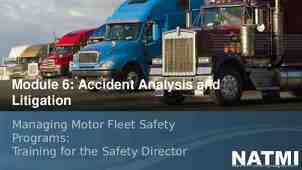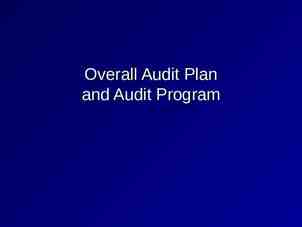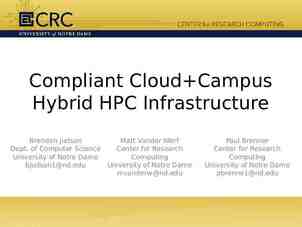Chapter 19 The Postwar Boom SECTION 1 Postwar America SECTION 2 The
29 Slides138.31 KB

Chapter 19 The Postwar Boom SECTION 1 Postwar America SECTION 2 The American Dream in the Fifties SECTION 3 Popular Culture SECTION 4 The Other America Summary Many Americans enjoy new material comforts and new forms of entertainment during the post-war economic boom. Yet racial gaps remain, and millions continue to live in poverty.

19.1 Postwar America Section 1 Postwar America The Truman and Eisenhower administrations lead the nation to make social, economic, and political adjustments following World War II. 2

19.1 Postwar America Readjustment and Recovery The Impact of the GI Bill 1944 GI Bill of Rights eases veterans’ return to civilian life Pays partial tuition, unemployment benefits; provides loans Housing Crisis 10 million returning veterans face housing shortage Developers use assembly-line methods to massproduce houses Build suburbs—small residential communities around cities 3

19.1 Postwar America Readjustment and Recovery cont. Redefining the Family Tensions from changed gender roles during war increase divorce rate Economic Readjustment Over 1 million defense workers laid off; wages drop for many workers Price controls end; 25% increase in cost of scarce consumer goods Congress reestablishes price, wage, rent controls Remarkable Recovery People have savings, service pay, war bonds; buy goods long missed Cold War keeps defense spending up; foreign aid creates markets 4

19.1 Postwar America Meeting Economic Challenges President Truman’s Inheritance Harry S. Truman can make difficult decisions, take responsibility Truman Faces Strikes 1946, higher prices, lower wages lead 4.5 million to strike Truman seizes mines, threatens to take over railroads Threatens to draft workers; unions give in “Had Enough?” Republicans win Senate, House; ignore Truman’s domestic policy Congress passes Taft-Hartley Act, overturns many union rights 5

19.1 Postwar America Social Unrest Persists Truman Supports Civil Rights African Americans, especially veterans, demand rights as citizens Congress rejects civil rights laws; Truman issues executive orders: - integrates armed forces; ends discrimination in government hiring The 1948 Election Southern Democrats—Dixiecrats—protest civil rights, form own party Truman calls special session; asks Congress for social legislation Congress refuses; Truman goes on “whistlestop campaign” 6

19.1 Postwar America Social Unrest Persists cont. Stunning Upset Truman defeats Thomas E. Dewey in close political upset Democrats regain control of Congress, lose some Southern states The Fair Deal Truman’s Fair Deal is ambitious economic program, includes: - higher minimum wage, flood control projects, low-income housing Congress passes parts of Fair Deal 7

19.1 Postwar America Republicans Take the Middle Road I Like Ike! Truman’s approval rating drops over Korean War, McCarthyism - decides not to run for reelection Gen. Dwight D. Eisenhower runs against IL governor Adlai Stevenson Newspapers accuse VP candidate Richard M. Nixon of corruption - defends self in televised “Checkers speech” Eisenhower wins; Republicans narrowly take Congress 8

19.1 Postwar America Republicans Take the Middle Road cont. Walking the Middle of the Road Eisenhower conservative about money, liberal on social issues Ike tries to avoid civil rights movement, which is gaining strength On economy, works for balanced budget, tax cut Pushes social legislation, new Dept. of Health, Education, Welfare Popularity soars; is reelected in 1956 9

19.2 The American Dream in the 50s Section 2 The American Dream in the Fifties During the 1950s, the economy booms, and many Americans enjoy material comfort. 10

19.2 The American Dream in the 50s The Organization and the Organization Man Employment in the U.S. By 1956, majority of Americans not in blue-collar (industrial) jobs More in higher-paying, white-collar (office, professional) positions Many in services, like sales, advertising, insurance, communications Conglomerates Conglomerates—corporation that owns smaller, unrelated companies Diversify to protect from downturns in individual industries 11

19.2 The American Dream in the 50s The Organization and the Organization Man cont. Franchises Franchise—company offers similar products, services in many places - also the right to use company name and system Fast-food restaurants among first, most successful franchises Social Conformity Many employees with well-paid, secure jobs lose individuality Personality tests see if job candidates fit in company culture Companies reward teamwork, loyalty, encourage conformity 12

19.2 The American Dream in the 50s The Suburban Lifestyle The Baby Boom 1950s, 85% of new homes built in suburbs 1945–1965 baby boom—soaring birth rate after soldiers return Advances in Medicine and Childcare New drugs fight, prevent childhood diseases Dr. Jonas Salk develops vaccine for poliomyelitis Pediatrician Dr. Benjamin Spock writes popular guide for parents Baby boom impacts economy, educational system 13

19.2 The American Dream in the 50s The Suburban Lifestyle cont. Women’s Roles Magazines, TV, movies glorify role of homemaker, mother Over 1/5 of suburban wives dissatisfied with their lives 1960, 40% mothers work; limited opportunities, less pay than men Leisure in the Fifties Shorter work week, paid vacation, labor-saving devices free up time People have time for recreational activities, spectator sports Book, magazine, comic book sales climb rapidly 14

19.2 The American Dream in the 50s The Automobile Culture Automania Cheap, plentiful gas, easy credit, advertising increase car sales No public transit in suburbs; cars necessary The Interstate Highway System Local, state roads link cities, suburbs to schools, shops, work Interstate Highway Act—nationwide highway network unites country Highways enable long-haul trucking, new towns, family vacations Towns near highways prosper; those near older, smaller roads decline 15

19.2 The American Dream in the 50s The Automobile Culture cont. Mobility Takes Its Toll Auto boom stimulates new businesses— e.g. drive-in movies Cars create social, environmental problems— e.g. accidents, pollution Upper-, middle-class whites leave cities; jobs, businesses follow Economic gulf widens between suburban and urban - also widens gap between middle class and the poor 16

19.2 The American Dream in the 50s Consumerism Unbound New Products 60% of Americans in middle class; twice as many as before WW II Consumerism (buying material goods) equated with success Numerous new products appear on market in response to demand Planned Obsolescence Planned obsolescence—making products that get outdated, wear out - makes consumers buy or want to buy new ones 17

19.2 The American Dream in the 50s Consumerism Unbound cont. Buy Now, Pay Later Credit purchases, credit cards, installments extend payment period Private debt grows; consumers confident of future prosperity The Advertising Age Most people have satisfied basic needs; ads encourage extra spending Psychological appeals in ads lure consumers to particular products Ads appear in all media; television emerges as powerful new tool 18

19.3 Popular Culture Section 3 Popular Culture Mainstream Americans, as well as the nation’s subcultures, embrace new forms of entertainment during the 1950s. 19

19.3 Popular Culture New Era of the Mass Media The Rise of Television Mass media—means of communication that reach large audiences TV first widely available 1948; in almost 90% of homes in 1960 Federal Communications Commission (FCC) regulates communications By 1956, FCC allows 500 stations to broadcast Programs: comedies, news, dramas, variety shows, children’s shows Lifestyle changes: TV Guide is popular magazine; TV dinners 20

19.3 Popular Culture New Era of the Mass Media cont. Stereotypes and Gunslingers Women, minorities on TV are stereotypes; few blacks, Latinos Westerns glorify historical frontier conflicts Raise concerns about effect of violence on children Radio and Movies Television cuts into radio, movie markets Radio turns to local news, weather, music, community affairs Movies capitalize on size, color, sound advantages; try gimmicks 21

19.3 Popular Culture A Subculture Emerges The Beat Movement Beat movement—writers, artists express social, literary nonconformity Poets, writers use free, open form; read works aloud in coffeehouses Beatnik attitudes, way of life attract media attention, students 22

19.3 Popular Culture African Americans and Rock ‘n’ Roll Rock ‘n’ Roll Black musicians add electric instruments to blues—rhythm and blues Rock ‘n’ roll—mix of rhythm and blues, country, pop Has heavy rhythm, simple melodies, lyrics about teenage concerns Music appeals to newly affluent teens who can buy records Many adults concerned music will lead to delinquency, immorality 23

19.3 Popular Culture African Americans and Rock ‘n’ Roll cont. The Racial Gap African-American singers like Nat “King” Cole, Lena Horne popular Many black artists play jazz, music characterized by improvisation African-American shows mostly broadcast on black radio stations - content, advertising target black audiences Important to black audiences with fewer TV sets, no presence on TV 24

19.4 The Other America Section 4 The Other America Amidst the prosperity of the 1950s, millions of Americans live in poverty. 25

19.4 The Other America The Urban Poor White Flight 1962, 25% of Americans below poverty level Post WW II–1960, 5 million blacks go from rural South to urban North White flight results in loss of businesses, tax payers to cities Cities can no longer afford to maintain or improve: - schools, public transportation, police and fire departments 26

19.4 The Other America The Urban Poor cont. The Inner Cities Poverty grows rapidly in decaying inner cities Poor economic conditions lead to illness and terrible conditions Urban Renewal Urban renewal—replace rundown buildings with new low-income housing Housing and Urban Development Dept. created to improve conditions Not enough housing built for displaced people 27

19.4 The Other America Poverty Leads to Activism Mexicans Seek Employment Many Southwest Mexicans become U.S. citizens after Mexican War 1942–47, Mexican braceros, hired hands, allowed into U.S. to work After war, many remain illegally; many others enter to look for work The Longoria Incident Undertaker refuses funeral services to Felix Longoria, WW II veteran Outraged Mexican-American veterans organize G.I. Forum Unity League of CA registers voters, promotes responsive candidates 28

19.4 The Other America Poverty Leads to Activism cont. Native Americans Continue their Struggle During Depression, U.S. policy of Native American autonomy National Congress of American Indians: civil rights, maintain customs U.S. stops family allotments, wages; outsiders take tribal lands The Termination Policy Termination policy cuts economic support, gives land to individuals Bureau of Indian Affairs helps resettlement in cities Termination policy is a failure; abandoned in 1963 29






